Power word: “A word that often evokes an emotional response, positive or negative, in the target audience, leading to a desired outcome.” You’ve probably heard of this term before.
It’s the practice of strategically using words to get readers to open and engage with your emails with the goal of making some type of conversion.
It’s linguistic persuasion if you will.
And when done correctly, power words can be incredibly potent.
In fact, a slight change in wording to a call-to-action helped Teespring increase their conversions by a whopping 12.7 percent.

For this post, I’ll take an in-depth look at the psychology behind power words within the context of e-commerce email marketing. Plus, I’ll explain how you can use them to get more opens, clicks, and conversions.

How to Use Power Words
The Classic Xerox Mindfulness Experiment
What Should Power Words Accomplish?
The Classic Xerox Mindfulness Experiment
In 1978, psychology researchers Ellen Langer, Arthur Blank and Benzion Chanowitz performed a study to determine how people responded to the same request but using different words.
It was called the Xerox Mindfulness Experiment and involved two actors—one male and one female—approaching people in a library and attempting to cut ahead of them to use the copy machines.
The actors asked one of three questions:
- Request only. “Excuse me, I have five pages. May I use the Xerox machine?
- Placebic information. “Excuse me, I have five pages. May I use the Xerox machine because I have to make copies?”
- Real information. “Excuse me, I have five pages. May I use the Xerox machine because I’m in a rush?”
The result?
- 60 percent complied when asked question #1;
- 93 percent complied when asked question #2 when a reason was given that the actor had to make copies;
- 94 percent complied when asked question #3 when a reason was given that the actor was in a rush.
The point here is that far more people complied when there was a reason for the request—even if it was bogus.
So if you want someone to take action, it’s best to give them a reason to.
By throwing in the word “because” in this experiment, people were much likelier to be persuaded.
And although this experiment is 40 years old, it continues to prove the impact that words have.
Even adding just a single word can be a total game changer.
As an email marketer, you can capitalize on this phenomenon.
And this is where power words come into play.
What Should Power Words Accomplish?
There are two main things you’re going for here.
One is to invoke emotion. The other is to trigger curiosity.
As marketer Debra Garber writes,
Research published by the Harvard Business Review found curiosity to be one of the most powerful triggers for virality. Since we have a hard time resisting our curiosity, strategic use of powerful words makes it almost impossible for us not to click, share and read.
So in most cases, these are the two goals that should be in the back of your mind, which brings me to my next points.
1. Targeting an Emotion
Do a quick search for “power words” on Google and you’ll find a boatload of examples.
This list of 108 power words includes some of the classics like “free,” “amazing,” “guaranteed,” and so on.
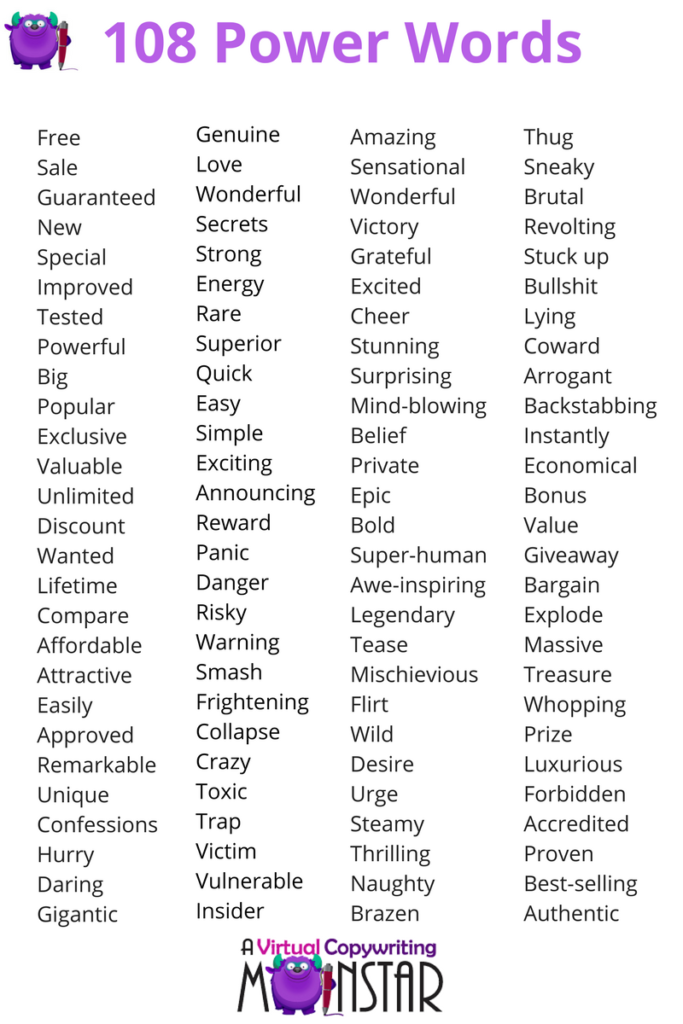
And that’s a great starting point.
But for your emails to truly hit their mark, the copy needs to be highly targeted and written with a specific goal in mind.
In other words, you need to use power words that target a particular emotion.
One of my favorite resources for help with this is SmartBlogger’s 595 Power Words That’ll Instantly Make You a Better Writer.
This is a massive list of power words you can use to appeal to a variety of emotions.
Here are a few examples:
Fear Power Words
- Agony
- Fool
- Plunge
Encouragement Power Words
- Amazing
- Fearless
- Score
Lust Power Words
- Allure
- Itching
- Sinful
You get the idea. This is a great place to quickly find potential power words for your emails based on the particular emotion you’re targeting.
As you go through these lists, I recommend taking some of your favorites and adding them to a spreadsheet for future reference.
After seeing how certain power words perform in your email campaign (which we’ll discuss shortly), you’ll eventually end up with a solid list on your hands that you can draw from time and time again.
2. Invoking Curiosity
Although you won’t be trying to invoke curiosity all of the time, it’s certainly an effective overall strategy and can play a key role in getting people to open your emails.
This relates to a psychological term called curiosity drive theory, which Josh Clark explains in HowStuffWorks is, “A naturally-occurring urge that must be satisfied in a very similar manner to how we satisfy our hunger by eating. When our curiosity becomes aroused, we look to new or old interests to satisfy the urge.”
I can personally testify to this because there have been many times where I’m on the fence about opening an email, but the subject line piques my curiosity to the point that I feel like I have to open it.
Otherwise, it’s going to bug me if I don’t.
Kind of like this…

Or this.

The resource I mentioned from SmartBlogger previously also contains a nice list of curiosity words.
Here are some of my favorites:
- Ancient
- Forbidden
- Smuggled
- Banned
- From the vault
So whenever it makes sense, pepper these types of curiosity-driven power words. It should prove fruitful.
Running Some Tests
At this point, we’ve established that words have power—some more than others.
We’ve found out that the primary purpose of power words is to invoke emotion and trigger curiosity.
I’ve also shared some helpful resources for coming up with ideas for power words to incorporate into your email subject lines, copy, etc.
But how do you know which specific words will have the biggest impact?
Here’s a technique that I suggest.
First, you’ll want to use something called the Emotional Marketing Value Headline Analyzer from the Advanced Marketing Institute.
It’s a great little tool that analyzes a subject line to determine its Emotional Marketing Value (EVM) and is free to use.
So here’s what you do.
Come up with several potential subject lines that target a particular emotion. Ideally, it will at least 10.
Let’s say that I’m looking to promote the “grow your email list” aspect of Drip's onsite campaigns.
More specifically I want to focus on how easy it is and convey this simplicity to prospects.
So I want to send prospects an email that directs them to Drip's Onsite guides so they can learn more about it.
Some potential subject lines featuring power words I might use could be:
- Grow your email list painlessly with these three steps
- Check out my step-by-step guide for growing your email list
- Here are some stupid-simple ways to grow your email list
Once I have some ideas in mind, I want to plug them into the tool I just mentioned to determine their EVM.
This would give me an idea of how well my subscribers would respond to each one.
So I’ll insert the first potential subject line, “Grow your email list painlessly with these three steps.”
Then click on the type or industry it belongs to—in this case, it’s business and professional services.
Now click on “Submit For Analysis.”
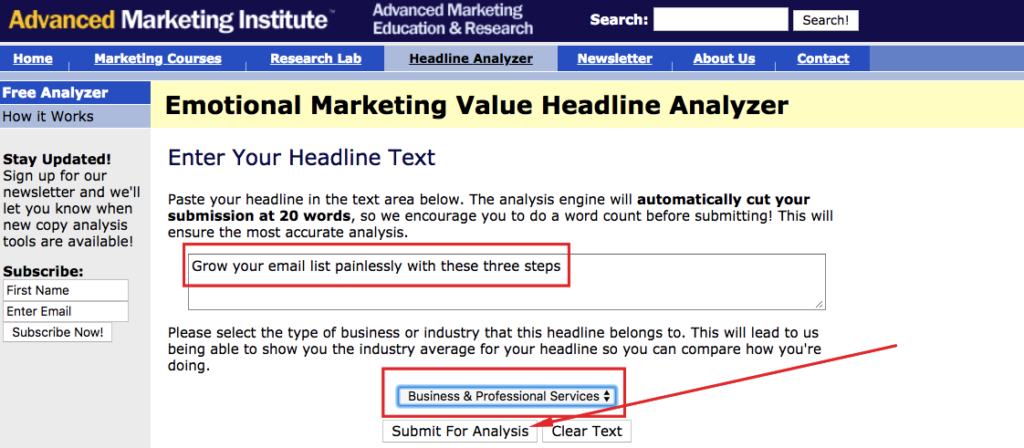
Here’s what I get.
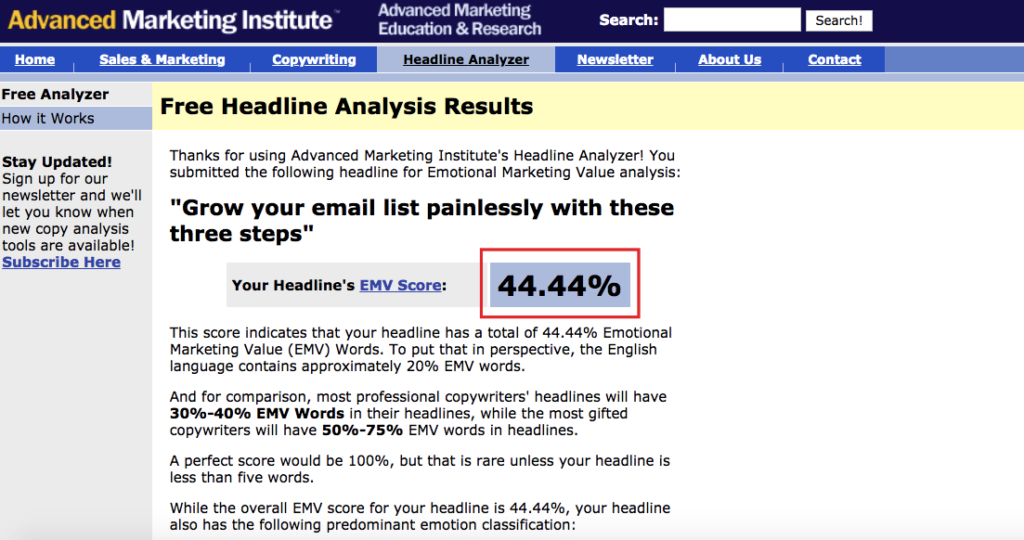
This one got a 44.44 percent EVM score, which is pretty good.
Now I want to repeat this process with my other two potential subject lines.
Here’s what I get for “Check out my step-by-step guide for growing your email list.”
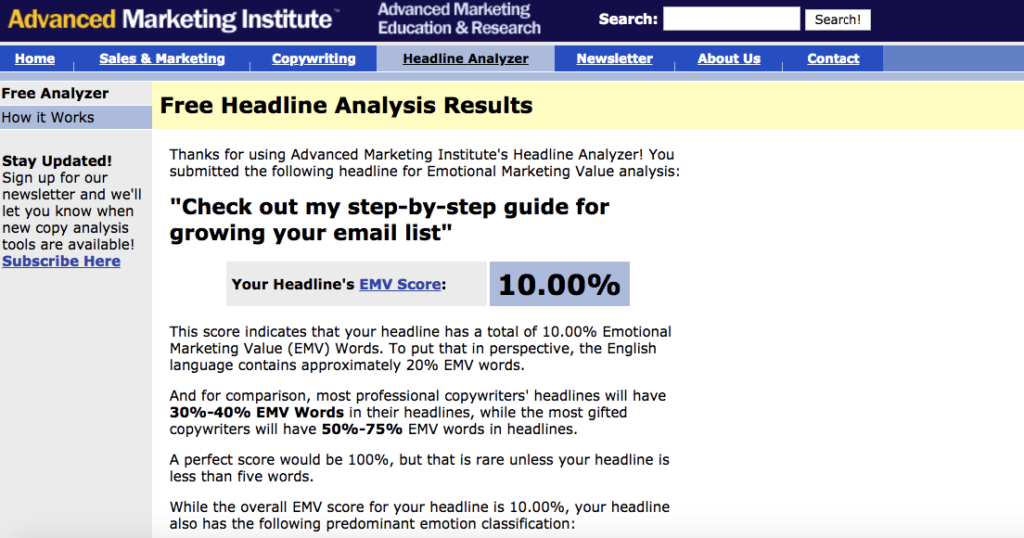
Not nearly as good at just 10 percent.
And for “Here are some stupid-simple ways to grow your email list.”
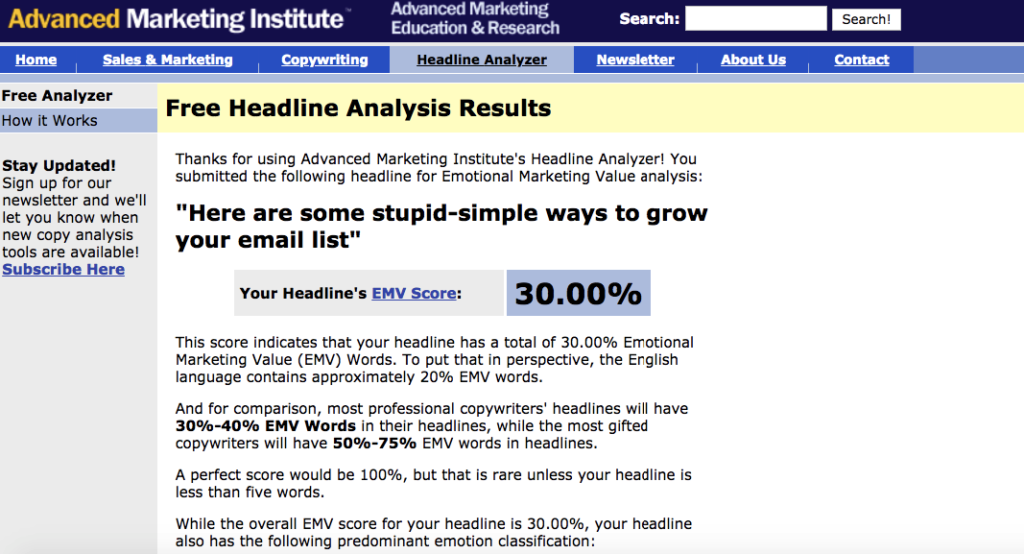
This is decent, but it’s clear that between my three potential subject lines, the first one would be the best because it has the highest EVM score.
I like this tool because it provides some objective insight into which power words and phrases an audience is most likely to be receptive to.
It takes something abstract like emotion and makes it quantifiable.
This isn’t to say that this tool is 100 percent flawless and perfect for every situation, but it’s nice for getting a baseline reading when you’re examining which power words to use.
Doing Some Additional A/B Testing
I’m a huge fan of A/B testing.
It can be used for practically every aspect of marketing, including email.
For this situation, you’ll want to check the results of the 10+ subject lines you plugged into the EVM tool.
Once you’ve gotten the results, grab the two subject lines with the highest EVM scores and test them side-by-side in an A/B test.
So you would want to use one subject line for 50 percent of recipients and the other subject line for the other 50 percent.
Check out the key metrics like the open rate and CTR to determine which power word(s) had the biggest impact.
The one that wins is what you’ll want to add to your master list so that you can remember it and use it again in the future.
Over time, you’ll have a killer list of power words that you know get results.
3 Techniques to Avoid
Just like there are some best practices when using power words, there are some things you’ll want to stay away from.
Here are three particular techniques that I suggest avoiding.
1. Overpromising
I feel like many email marketers are great at coming up with catchy subject lines that are quite compelling.
But once you actually open it, you can’t help but be underwhelmed.
Here’s an example.

Making huge claims or using power words like “astonishing” and “jaw-dropping” or implying that a person can get rich are real attention grabbers.
But if you fail to deliver, any rapport or trust you’ve built up until this point is likely to take a hit.
And this can lead to your emails being marked as spam, unsubscribes, and so on.
In other words, you should stay away from anything that could be deemed as clickbait.
2. Going Overboard with Power Words
Use a few power words here and there, and you should have a well-crafted email that targets readers’ emotions and grabs their attention.
But go overboard and stuff your copy with power words, and it can become obnoxious in a hurry.
For instance, you wouldn’t want to use “mesmerizing,” “spell-binding” and “unbelievable” in the same subject line.
It’s only going to make you come across as being insincere and perhaps even spammy.
The key is to use power words sparingly and strike a nice balance between them and the rest of your copy.
3. Creating Exaggerated Urgency
Urgency is a potent tactic.
One report found, “Emails conveying a sense of urgency had at least 14 percent higher click-to-open rates, 59 percent higher transaction-to-click rates, and twice as high transaction rates compared to average marketing emails.
So it can certainly get results.


But you shouldn’t use exaggerated urgency to the point that it’s just hype.
While using words like “before they disappear,” “one time only” and “last chance” can be effective, only use them when they legitimately apply.
Otherwise, this too can create a rift between you and your subscribers.

Conclusion
As humans, we’re biologically-driven to be receptive to certain words.
Some naturally get a rise out of us. It’s really that simple.
Knowing which power words to use is incredibly valuable from an email marketing standpoint.
It’s like a hack that dramatically increases the effectiveness of your campaign.
By pulling the right strings, people are more likely to open, read and click-through.
Following the tactics outlined here should help you make the most out of power words, while at the same time using them responsibly.
And once you get a feel for it and figure out what your subscribers are responding to, you can seamlessly work them into your copy for maximum impact.



